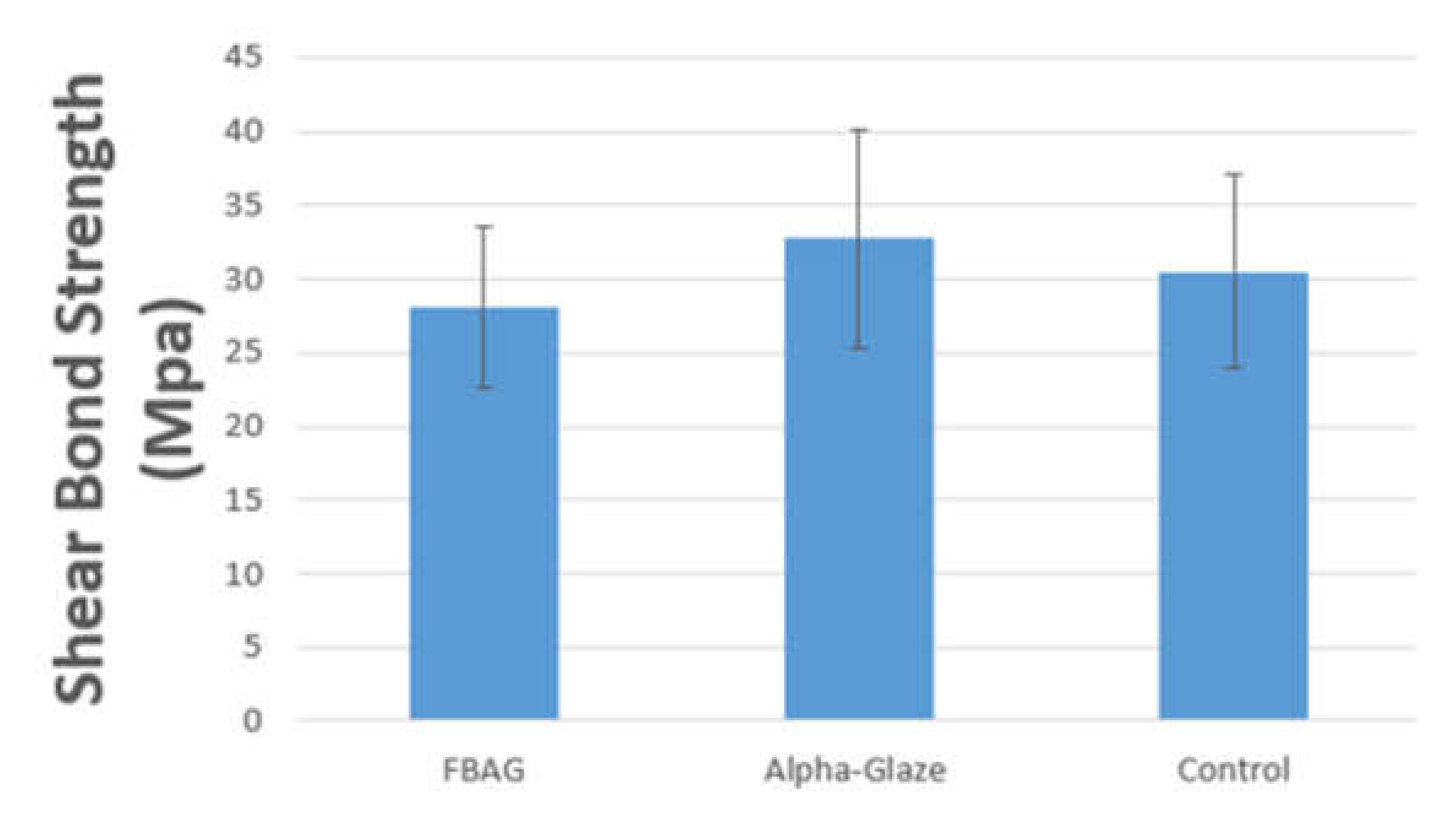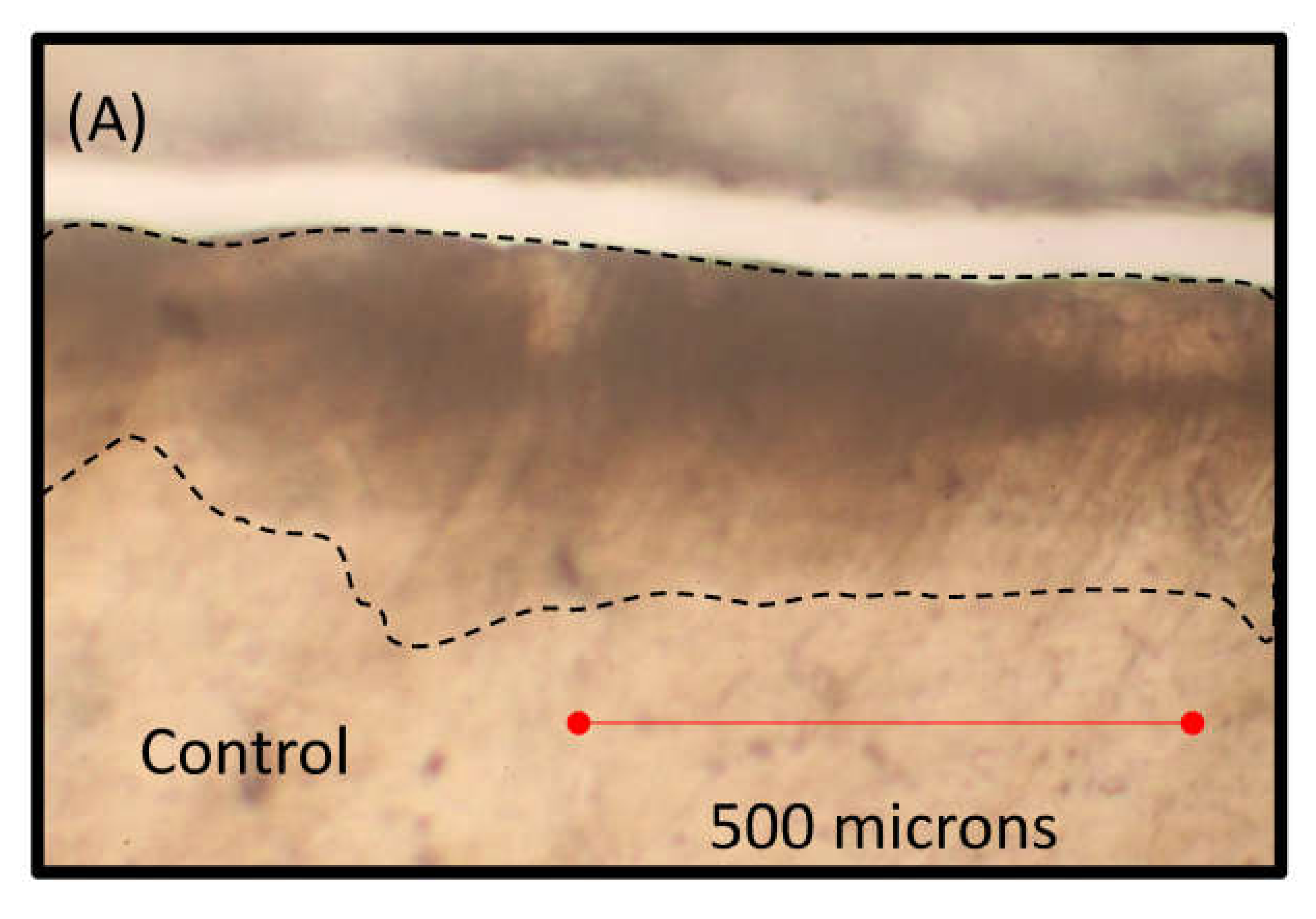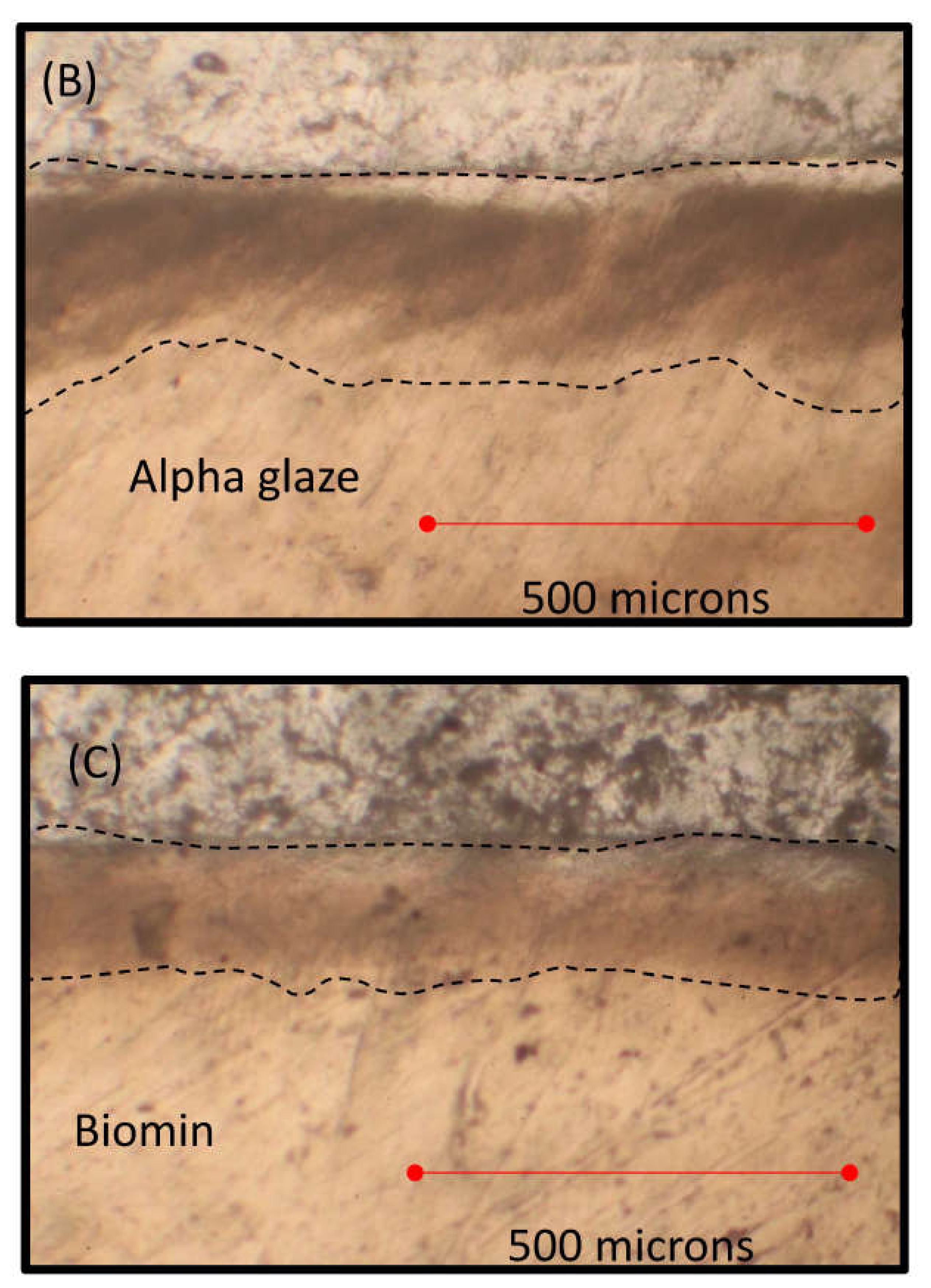Evaluation of Bioactive Glass and Low Viscosity Resin as Orthodontic Enamel Sealer: An In Vitro Study
Abstract
1. Introduction
- There will be a negative effect on shear bond strength of Transbond XT to tooth structure after the application of the fluoride bioactive glass or Alpha-Glaze sealer onto enamel surface when compared to Transbond XT.
- There will be no differences in brushing abrasion resistance after the application of the fluoride bioactive glass when compared to the Alpha-Glaze sealer.
- There will be no protective effect differences in protecting the teeth from demineralization after the application of the fluoride bioactive glass or Alpha-Glaze sealer when compared to the intact enamel surface.
2. Materials and Methods
2.1. Specimen Preparation
2.2. Tested Materials Application
2.3. Transbond XT Application
2.4. Shear Bond Strength Test (SBS)
2.5. Adhesive Remnant Index (ARI)
2.6. Brushing Abrasion Challenge Test
2.7. Transmitted Light Microscopy Examination
2.8. Statistical Analysis
3. Results
3.1. Shear Bond Strength Test (SBS)
3.2. Adhesive Remnant Index (ARI) Results
3.3. Brushing Abrasion Challenge Test Results
3.4. Transmitted Light Microscopy Examination Results
4. Discussion
- There was no negative effect on the shear bond strength of Transbond XT to tooth structure after application of the fluoride bioactive glass or Alpha-Glaze sealer onto the enamel surface when compared to Transbond XT.
- Brushing abrasion affected the fluoride bioactive glass formed layer when compared to the Alpha-Glaze resin sealer layer.
- The fluoride bioactive glass exerted a more protective effect on enamel when compared to the Alpha-Glaze sealer.
5. Conclusions
Author Contributions
Funding
Institutional Review Board Statement
Informed Consent Statement
Data Availability Statement
Conflicts of Interest
References
- Lucchese, A.; Gherlone, E. Prevalence of white-spot lesions before and during orthodontic treatment with fixed appliances. Eur. J. Orthod. 2013, 35, 664–668. [Google Scholar] [CrossRef] [PubMed]
- Julien, K.C.; Buschang, P.H.; Campbell, P.M. Prevalence of white spot lesion formation during orthodontic treatment. Angle Orthod. 2013, 83, 641–647. [Google Scholar] [CrossRef] [PubMed]
- Paolone, M.G.; Kaitsas, R.; Paolone, G.; Kaitsas, V. Lingual orthodontics and forced eruption: A means for osseous and tissue regeneration. Prog. Orthod. 2008, 9, 46–57. [Google Scholar] [PubMed]
- Premaraj, T.S.; Rohani, N.; Covey, D. In vitro evaluation of surface properties of Pro Seal. Orthod. Craniofacial Res. 2017, 20 (Suppl. 1), 134–138. [Google Scholar] [CrossRef]
- Boersma, J.; van der Veen, M.; Lagerweij, M.; Bokhout, B.; Prahl-Andersen, B. Caries Prevalence Measured with QLF after Treatment with Fixed Orthodontic Appliances: Influencing Factors. Caries Res. 2005, 39, 41–47. [Google Scholar] [CrossRef]
- Kachuie, M.; Khoroushi, M. Prevention and treatment of white spot lesions in orthodontic patients. Contemp. Clin. Dent. 2017, 8, 11–19. [Google Scholar] [CrossRef]
- Srivastava, K.; Tikku, T.; Khanna, R.; Sachan, K. Risk factors and management of white spot lesions in orthodontics. J. Orthod. Sci. 2013, 2, 43–49. [Google Scholar] [CrossRef]
- Benson, P.E.; Shah, A.A.; Millett, D.T.; Dyer, F.; Parkin, N.; Vine, R.S. Fluorides, orthodontics and demineralization: A systematic review. J. Orthod. 2005, 32, 102–114. [Google Scholar] [CrossRef]
- Chang, H.S.; Walsh, L.; Freer, T.J. Enamel demineralization during orthodontic treatment. Aetiology and prevention. Aust. Dent. J. 1997, 42, 322–327. [Google Scholar] [CrossRef]
- Gupta, A.K.; Shukla, G.; Sharma, P.; Gupta, A.K.; Kumar, A.; Gupta, D. Evaluation of the Effects of Fluoride Prophylactic Agents on Mechanical Properties of Nickel Titanium Wires using Scanning Electron Microscope. J. Contemp. Dent. Pract. 2018, 19, 283–286. [Google Scholar] [CrossRef]
- Abbassy, M.A. Fluoride influences nickel-titanium orthodontic wires’ surface texture and friction resistance. J. Orthod. Sci. 2016, 5, 121–126. [Google Scholar] [CrossRef] [PubMed]
- DenBesten, P.; Li, W. Chronic Fluoride Toxicity: Dental Fluorosis. Fluoride Oral Environ. 2011, 22, 81–96. [Google Scholar] [CrossRef]
- Premaraj, T.S.; Rohani, N.; Covey, D.; Premaraj, S.; Hua, Y.; Watanabe, H. An in-vitro evaluation of mechanical and esthetic properties of orthodontic sealants. Eur. J. Dent. 2014, 8, 487–492. [Google Scholar] [CrossRef] [PubMed]
- Pithon, M.M.; Santos, M.D.J.; De Souza, C.A.; Filho, J.C.B.L.; Braz, A.K.S.; De Araujo, R.E.; Tanaka, O.M.; Oliveira, D.D.; Leão, J.C.B. Effectiveness of fluoride sealant in the prevention of carious lesions around orthodontic brackets: An OCT evaluation. Dent. Press J. Orthod. 2015, 20, 37–42. [Google Scholar] [CrossRef] [PubMed][Green Version]
- Abbassy, M.A.; Masoud, A.I.; Alsulaimani, F.F.; Bakry, A.S. Effect of citric acid erosion on enamel and dentin and possible protection by a novel bioactive borate adhesive system. J. Dent. 2022, 124, 104208. [Google Scholar] [CrossRef] [PubMed]
- MAbbassy, M.A.; Bakry, A.S.; Almoabady, E.H.; Almusally, S.M.; Hassan, A.H. Characterization of a novel enamel sealer for bioactive remineralization of white spot lesions. J. Dent. 2021, 109, 103663. [Google Scholar] [CrossRef]
- Abbassy, M.A.; Bakry, A.S.; Hill, R. The Efficiency of Fluoride Bioactive Glasses in Protecting Enamel Surrounding Orthodontic Bracket. BioMed Res. Int. 2021, 2021, 5544196. [Google Scholar] [CrossRef]
- Bakry, A.; Takahashi, H.; Otsuki, M.; Tagami, J. The durability of phosphoric acid promoted bioglass–dentin interaction layer. Dent. Mater. 2013, 29, 357–364. [Google Scholar] [CrossRef]
- Bakry, A.; Abbassy, M.; Alshehri, N.; Alghamdi, T.; Rafiq, S.; Aljeddawi, D.; Nujaim, D.; Hassan, A. 45S5 Bioglass paste is capable of protecting the enamel surrounding orthodontic brackets against erosive challenge. J. Orthod. Sci. 2019, 8, 5. [Google Scholar] [CrossRef]
- Abbassy, M.A.; Linjawi, A.I. Comparison of shear bond strength to clinically simulated debonding of orthodontic brackets: An in vitrostudy. J. Orthod. Sci. 2016, 5, 25–29. [Google Scholar] [CrossRef]
- Buren, J.L.; Staley, R.N.; Wefel, J.; Qian, F. Inhibition of enamel demineralization by an enamel sealant, Pro Seal: An in-vitro study. Am. J. Orthod. Dentofac. Orthop. 2008, 133, S88–S94. [Google Scholar] [CrossRef]
- Abbassy, M.A. A Bioactive Enamel Sealer Can Protect Enamel during Orthodontic Treatment: An In Vitro Study. Coatings 2022, 12, 550. [Google Scholar] [CrossRef]
- Bishara, S.E.; Forrseca, J.M.; Fehr, D.E.; Boyer, D.B. Debonding forces applied to ceramic brackets simulating clinical conditions. Angle Orthod. 1994, 64, 277–282. [Google Scholar] [CrossRef] [PubMed]
- Cochrane, N.J.; Lo, T.W.; Adams, G.G.; Schneider, P.M. Quantitative analysis of enamel on debonded orthodontic brackets. Am. J. Orthod. Dentofac. Orthop. 2017, 152, 312–319. [Google Scholar] [CrossRef] [PubMed]
- Mitwally, R.A.; Bakhsh, Z.T.; Feteih, R.M.; Bakry, A.S.; Abbassy, M.A. Orthodontic Bracket Bonding Using Self-adhesive Cement to Facilitate Bracket Debonding. J. Adhes. Dent. 2019, 21, 551–556. [Google Scholar] [CrossRef] [PubMed]
- Abbassy, M.A.; Bakry, A.S.; Hill, R.; Hassan, A.H. Fluoride bioactive glass paste improves bond durability and remineralizes tooth structure prior to adhesive restoration. Dent. Mater. 2021, 37, 71–80. [Google Scholar] [CrossRef] [PubMed]
- Bakry, A.S.; Abbassy, M.A.; Alharkan, H.F.; Basuhail, S.; Al-Ghamdi, K.; Hill, R. A Novel Fluoride Containing Bioactive Glass Paste is Capable of Re-Mineralizing Early Caries Lesions. Materials 2018, 11, 1636. [Google Scholar] [CrossRef]
- Pont, H.B.; Özcan, M.; Bagis, B.; Ren, Y. Loss of surface enamel after bracket debonding: An in-vivo and ex-vivo evaluation. Am. J. Orthod. Dentofac. Orthop. 2010, 138, e1-387.e9. [Google Scholar] [CrossRef]
- Sofan, E.; Sofan, A.; Palaia, G.; Tenore, G.; Romeo, U.; Migliau, G. Classification review of dental adhesive systems: From the IV generation to the universal type. Ann. Stomatol. 2017, 8, 1–17. [Google Scholar] [CrossRef]
- Barbour, M.E.; Parker, D.M.; Allen, G.C.; Jandt, K.D. Enamel dissolution in citric acid as a function of calcium and phosphate concentrations and degree of saturation with respect to hydroxyapatite. Eur. J. Oral Sci. 2003, 111, 428–433. [Google Scholar] [CrossRef]
- Yu, H.; Wegehaupt, F.; Wiegand, A.; Roos, M.; Attin, T.; Buchalla, W. Erosion and abrasion of tooth-colored restorative materials and human enamel. J. Dent. 2009, 37, 913–922. [Google Scholar] [CrossRef]
- Sideridou, I.; Tserki, V.; Papanastasiou, G. Study of water sorption, solubility and modulus of elasticity of light-cured dimethacrylate-based dental resins. Biomaterials 2003, 24, 655–665. [Google Scholar] [CrossRef]
- Takahashi, M.; Nakajima, M.; Hosaka, K.; Ikeda, M.; Foxton, R.M.; Tagami, J. Long-term evaluation of water sorption and ultimate tensile strength of HEMA-containing/-free one-step self-etch adhesives. J. Dent. 2011, 39, 506–512. [Google Scholar] [CrossRef] [PubMed]
- Prakki, A.; Cilli, R.; Vieira, I.M.; Dudumas, K.; Pereira, J.C. Water sorption of CH3- and CF3-Bis-GMA based resins with additives. J. Appl. Oral Sci. 2012, 20, 472–477. [Google Scholar] [CrossRef] [PubMed]
- Braden, M. The formulation of composite filling materials. Oper. Dent. 1978, 3, 97–102. [Google Scholar] [PubMed]
- Coordes, S.L.; Jost-Brinkmann, P.-G.; Präger, T.M.; Bartzela, T.; Visel, D.; Jäcker, T.; Müller-Hartwich, R. A comparison of different sealants preventing demineralization around brackets. J. Orofac. Orthop. Fortschr. Kieferorthopädie 2018, 79, 49–56. [Google Scholar] [CrossRef] [PubMed]






| Product | Composition |
|---|---|
| (22–24 mol % Na2O, 28–30 mol % CaO, 4–6 mol % P2O5, 36–40 mol % SiO2, and 1.5–3.0 mol % CaF2) |
| BIS-GMA 40–50%, Blend of multifunctional Methacrylates 30–40%, THF Methacrylate 20–30%, Photo initiator < 1% Stabilizer < 1% |
| Silane-treated quartz, (Bisgma), (2-hydroxyethyl ether), Silane-treated silica |
| Group | Enamel Surface Preparation | Number |
|---|---|---|
| FBAG | Biomin + 35% phosphoric acid + 35% Phosphoric acid + Transbond XT primer + Transbond XT adhesive | Total N = 45 Shear Bond Strength Test = 15 Brushing Abrasion Challenge Test = 15 Transmitted Light Microscopy Examination = 15 |
| Alpha-Glaze sealer | 35% Phosphoric acid + Alpha-Glaze sealer Transbond XT primer + Transbond XT adhesive | Total N = 45 Shear Bond Strength Test = 15 Brushing Abrasion Challenge Test = 15 Transmitted Light Microscopy Examination = 15 |
| Transbond XT (Control) | 35% Phosphoric acid + Transbond XT primer + Transbond XT adhesive | Total N = 45 Shear Bond Strength Test =15 Brushing Abrasion Challenge Test = 15 Transmitted Light Microscopy Examination = 15 |
| Score | Reading |
|---|---|
| 0 | No adhesive remanent on the tooth surface |
| 1 | If there was less than 50% adhesive remanent on the tooth surface |
| 2 | If there is more than 50% adhesive remanent on the tooth surface |
| 3 | 100% of the adhesive remanent with a visible bracket impression |
| 4 | Any of the enamel chipping off could be detected |
| Material | Shear Bond Strength | |
|---|---|---|
| FBAG group | (28.1 ± 5.5 Mpa) | |
| Alpha-Glaze group | (32.5 ± 7.4 Mpa) | |
| Transbond XT (Control) | (30.7 ± 6.5 Mpa) | |
| Post Hoc Comparisons | ||
| ptukey | ||
| Alpha-Glaze | FBAG | 0.264 |
| Alpha-Glaze | TransBond XT | 0.774 |
| FBAG | TransBond XT | 0.632 |
| Score | FBAG | Alpha-Glaze | Transbond XT (Control) |
|---|---|---|---|
| Score 0 No adhesive left on the tooth | 6 40% | 3 20% | 5 33.30% |
| Score 1 Less than 50% adhesive left on the tooth | 9 60% | 5 33.3% | 5 33.3% |
| Score 2 More than 50% adhesive left on the tooth | 4 26.6% | ||
| Score 3 100% of the adhesive left on the tooth | 6 40% | ||
| Score 4 If any enamel chipping off could be detected | 1 6.6% | 1 6.6% |
| Score | FBAG | Alpha-Glaze |
|---|---|---|
| Score 0 No material left on the tooth | ||
| Score 1 Less than 50% of the material left on the tooth | 100% | |
| Score 2 More than 50% of the material left on the tooth | ||
| Score 3 All of the material left on the tooth | 100% |
Publisher’s Note: MDPI stays neutral with regard to jurisdictional claims in published maps and institutional affiliations. |
© 2022 by the authors. Licensee MDPI, Basel, Switzerland. This article is an open access article distributed under the terms and conditions of the Creative Commons Attribution (CC BY) license (https://creativecommons.org/licenses/by/4.0/).
Share and Cite
Al Shehab, A.; Bakry, A.S.; Hill, R.; Alsulaimani, F.F.; Abbassy, M.A. Evaluation of Bioactive Glass and Low Viscosity Resin as Orthodontic Enamel Sealer: An In Vitro Study. J. Funct. Biomater. 2022, 13, 191. https://doi.org/10.3390/jfb13040191
Al Shehab A, Bakry AS, Hill R, Alsulaimani FF, Abbassy MA. Evaluation of Bioactive Glass and Low Viscosity Resin as Orthodontic Enamel Sealer: An In Vitro Study. Journal of Functional Biomaterials. 2022; 13(4):191. https://doi.org/10.3390/jfb13040191
Chicago/Turabian StyleAl Shehab, Abdullah, Ahmed Samir Bakry, Robert Hill, Fahad Faiz Alsulaimani, and Mona Aly Abbassy. 2022. "Evaluation of Bioactive Glass and Low Viscosity Resin as Orthodontic Enamel Sealer: An In Vitro Study" Journal of Functional Biomaterials 13, no. 4: 191. https://doi.org/10.3390/jfb13040191
APA StyleAl Shehab, A., Bakry, A. S., Hill, R., Alsulaimani, F. F., & Abbassy, M. A. (2022). Evaluation of Bioactive Glass and Low Viscosity Resin as Orthodontic Enamel Sealer: An In Vitro Study. Journal of Functional Biomaterials, 13(4), 191. https://doi.org/10.3390/jfb13040191





